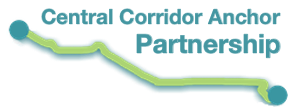
With the METRO Green Line just outside its front door, leaders at Regions Hospital have announced that employees can obtain monthly Metropasses at no direct cost. A Metropass provides unlimited rides on fares up to $3 and can be used to ride light rail, as well as any local or express bus. Regions will fully cover the cost of the pass for its employees.Metropass Card
This major move by Regions sets a strong example in the Central Corridor Anchor Partnership, which seeks to increase transit use among all anchor partners by 5% in five years through improved transit pass options and increased transit marketing and outreach. More than a dozen Regions employees will begin using a Metropass this month and Terry Gustafson, Parking Manager at Regions Hospital, expects interest will quickly grow once employees learn of the opportunity.
Best Practices Toolkit
The Partnership worked with Metro Transit to develop a Transit Toolkitto aid partners through a “Best Practices Checklist for the Multimodal Institution.” Regions plans to utilize this toolkit by adding transit information to its website and promoting the Green Line and other options to employees and visitors. The Green Line’s Robert Street Station is just a block west of Regions.
“With 3,100 employees, parking is a major challenge,” Gustafson said. “Having access to transit will relieve some of the burden on our parking areas, benefit the environment and help employees lead healthier lifestyles.” Regions previously offered employees a 25 percent discount on a 31-Day transit pass. Employees have expressed more interest in transit since the Green Line opened, prompting the switch to the Metropass program.
Metro Transit General Manager Brian Lamb said companies like Regions that invest in transportation options not only provide a great benefit for their employees but create more opportunity to invest in talent and critical infrastructure. “Like many Twin Cities employers, Regions is grappling with the best way to handle organizational growth,” he said. “Providing employees a cost-effective alternative to driving is a great way to ease parking demands while allowing companies to focus resources on their primary mission.”
Transit an Investment in Health
Regions CEO Megan Remark also highlighted that transit is an important strategy to promote community health. “We learned through our community health needs assessment that unfortunately, the percentage of obese adults in Minnesota has increased significantly from 15.3% in 1995 to 25.40% in 2010,” she said. This assessment also reported that in 2010, a higher percentage of 9th and 12th graders in Ramsey County were overweight and obese as their same age peers in Dakota and Washington counties. “We know that better nutrition and exercise are key strategies to address this problem,” Remark noted. “And people who take transit average 30% more steps each day.”
The U.S. Centers for Disease Control (CDC) recommends that adults average at least 22 minutes of daily moderate physical activity, such as walking, to reduce their risk of heart disease, obesity, stroke and diabetes. Although less than half of American adults achieve this target of 22 minutes or more, most public transportation passengers do exercise the recommended amount while walking to and from transit stations and stops. Read more at The Health Benefits of Walking + Transit.
